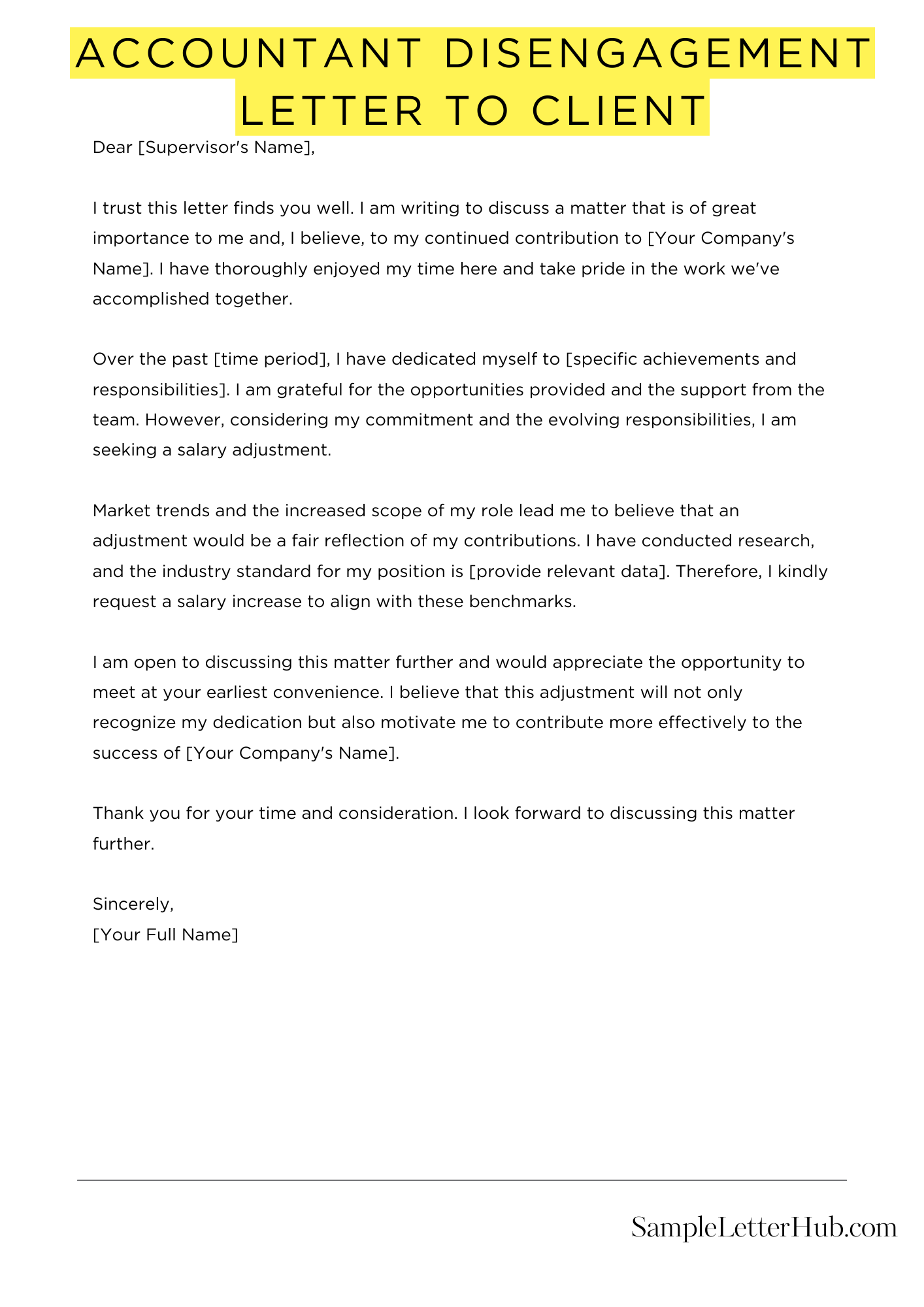An Accountant Disngagement letter is a formal letter that an Accountant uses to terminate their professional relationship with a client. The letter outlines the reason for the disngagement, the date of termination, and any other relevant information.
In this article, we will share 3 samples of Accountant Disngagement letter To Clients. These samples will provide you with a framework to write your own letter, and make it easy for you to write any letter that you are trying to write.
Accountant Disengagement Letter to Client
Dear [Client Name],
Please accept this letter as formal notification that I will be disengaging as your accountant, effective [date]. This decision was not made lightly and is the result of careful consideration.
Over the past [number] years, I have valued our professional relationship and the opportunity to assist you with your accounting needs. However, recent circumstances have made it necessary for me to reassess my workload and priorities.
I understand that this may be an unexpected change, and I want to assure you that I am committed to ensuring a smooth transition. I will provide you with all necessary documentation and records to facilitate the transfer of your accounting services.
I would also like to recommend [new accountant’s name] as a suitable replacement. They have a strong reputation in the industry and are well-equipped to handle your accounting needs.
I want to express my sincere gratitude for the trust and confidence you have placed in me. I wish you all the best in your future endeavors.
Please do not hesitate to contact me if you have any questions or require any assistance during the transition process.
Sincerely,
[Your Name]

How to Write Accountant Disengagement Letter To Client
Writing a disengagement letter to a client can be a daunting task, but it is an important step in the process of ending a professional relationship. A well-written disengagement letter will help to protect both the accountant and the client from any potential legal or financial liability.
1. Start with a Formal Salutation
The first step in writing a disengagement letter is to start with a formal salutation. This should include the client’s name, address, and date.
2. State the Purpose of the Letter
The next step is to state the purpose of the letter. This should be done in a clear and concise manner. For example, you could write: “I am writing to inform you that I will be disengaging as your accountant, effective [date].”
3. Explain the Reasons for Disengagement
If you are disengaging for a specific reason, such as a conflict of interest or a change in the client’s business, you should explain this in the letter. However, you are not obligated to provide a reason for disengaging.
4. Provide a Timeline for Disengagement
It is important to provide a timeline for disengagement in the letter. This will help to ensure that both the accountant and the client have ample time to transition to a new relationship.
5. Offer to Assist with the Transition
If you are able to assist with the transition to a new accountant, you should offer to do so in the letter. This could include providing the client with a list of potential replacements or helping to transfer the client’s files.
6. Request a Written Acknowledgment
It is important to request a written acknowledgment from the client that they have received and understood the disengagement letter. This will help to protect the accountant from any future claims.
7. Close with a Professional Salutation
The final step in writing a disengagement letter is to close with a professional salutation. This should include your name and signature.
FAQs about Accountant Disengagement Letter To Client
What is an accountant disengagement letter?
An accountant disengagement letter is a formal document that is sent by an accountant to a client to terminate their professional relationship. It typically includes the reasons for the disengagement, the effective date of the termination, and any outstanding fees or obligations.
When should an accountant send a disengagement letter?
An accountant should send a disengagement letter when they are no longer able to provide services to a client. This may be due to a number of reasons, such as a conflict of interest, a lack of resources, or a disagreement with the client.
What should be included in an accountant disengagement letter?
An accountant disengagement letter should include the following information:
- The date of the letter
- The name and address of the client
- The name and address of the accountant
- The reason for the disengagement
- The effective date of the termination
- Any outstanding fees or obligations
What are the consequences of sending a disengagement letter?
Sending a disengagement letter can have a number of consequences, including:
- The client may be required to find a new accountant
- The client may lose access to the accountant’s records
- The client may be liable for any outstanding fees or obligations
How can I avoid sending a disengagement letter?
There are a number of things that accountants can do to avoid sending a disengagement letter, including:
- Communicating regularly with clients
- Being transparent about fees and obligations
- Resolving disagreements promptly

